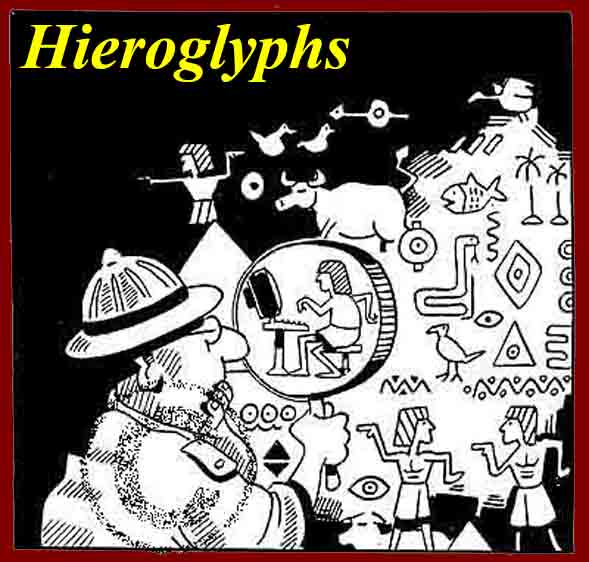
http://www.mmdtkw.org/EGtkw0300Hieroglyphis.jpg
An Egyptologist peers at his latest find.
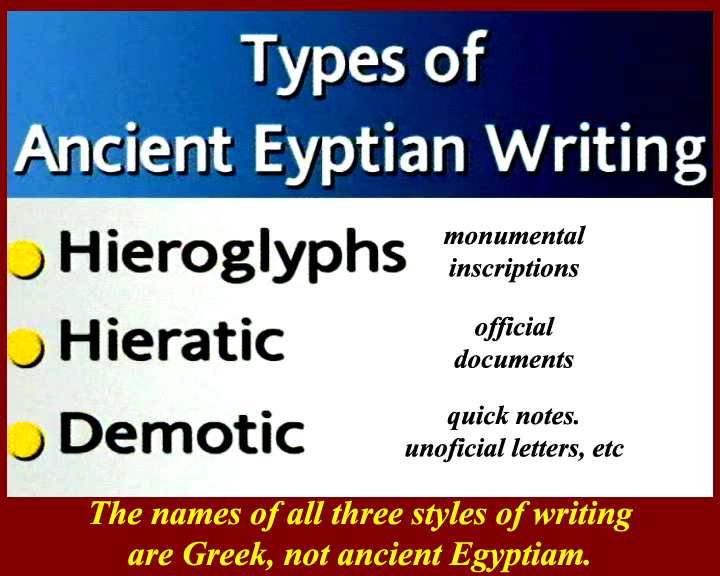
http://www.mmdtkw.org/EGtkw0301EgyptianScripts.jpg
Hieroglyphs appear to have developed from pictographs, and hieratic script uses simplified hieroglyphs. During the New Kingdom demotic script was developed for quicker work.
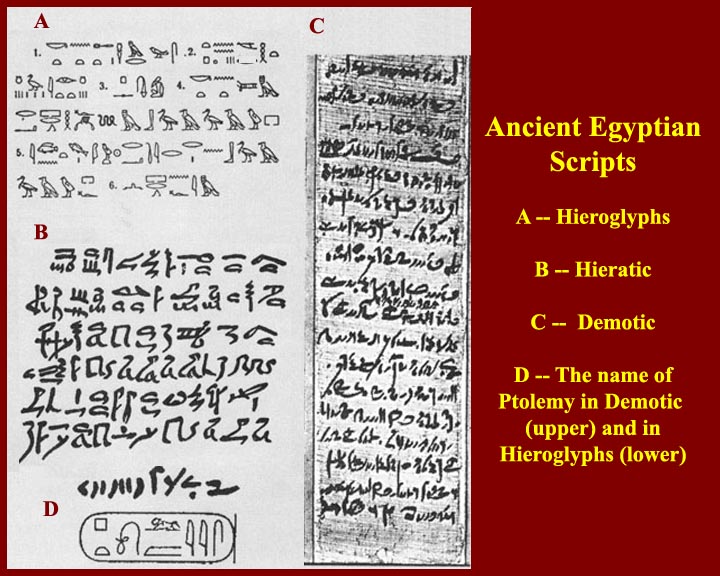
http://www.mmdtkw.org/EGtkw0302EgyptianScripts2.jpg
Examples of hieroglyphic, hieratic, and demotic writing.
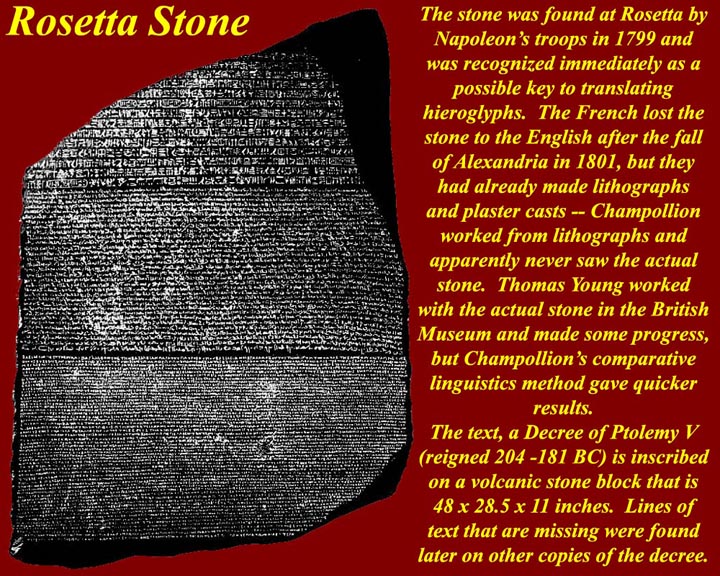
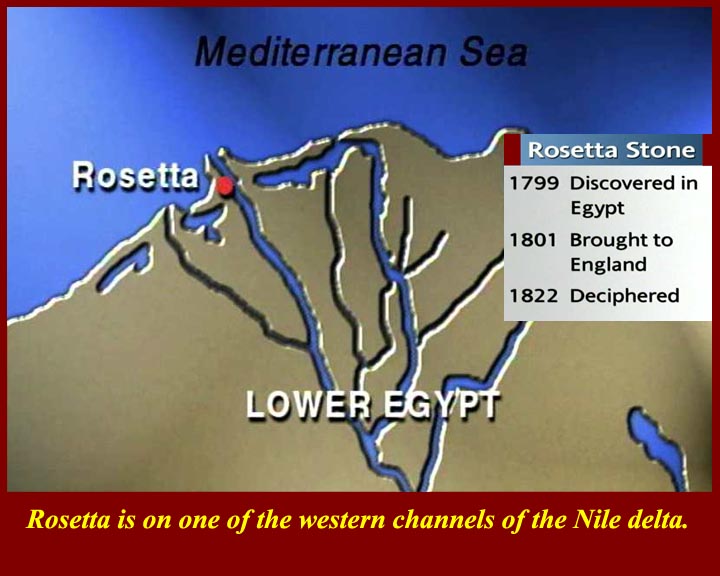
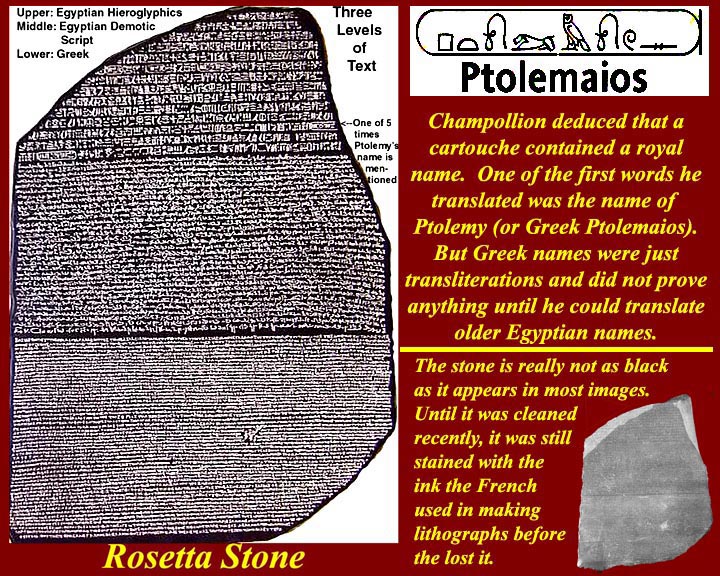
http://www.mmdtkw.org/EGtkw0304RosettaStone.jpg
http://www.mmdtkw.org/EGtkw0305RosettaMap .jpg
http://www.mmdtkw.org/EGtkw0306RosettaStone1.jpg
The Rosetta Stone, an announcement by Ptolemy V reigned 202 - 181 BC), was inscribed in three scripts: hieroglyphic, demotic, and Greek. There was never any doubt that the stone would be the key to translating ancient Egyptian -- it just took longer than expected.
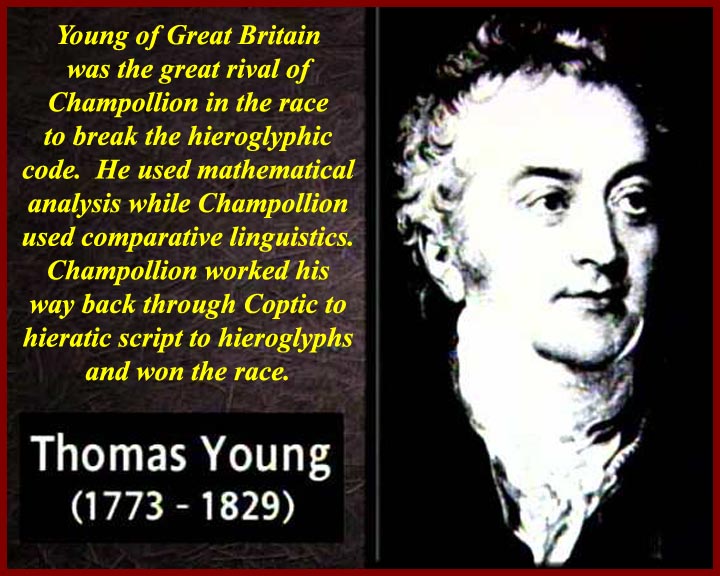
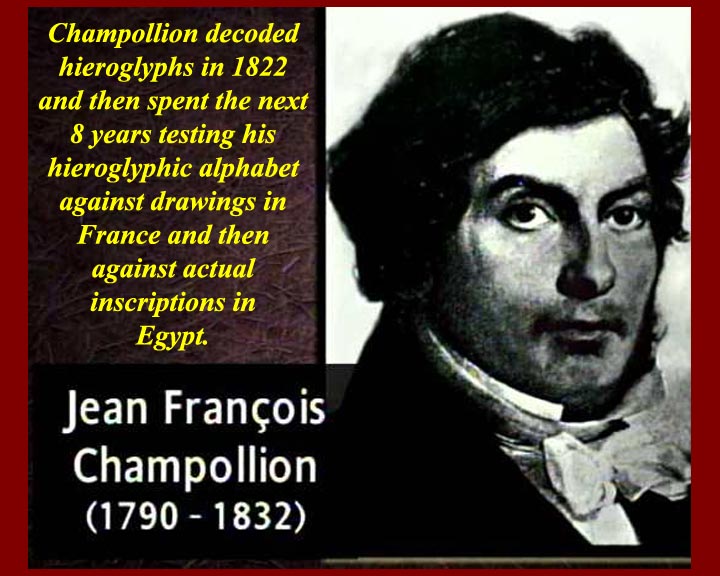
http://www.mmdtkw.org/EGtkw0307ThomasYoung.jpg
http://www.mmdtkw.org/EGtkw0308Champollion.jpg
The RosesttsStone was in British hands and the brilliant British scientist, Thomas Young (http://en.wikipedia.org/wiki/Thomas_Young_(scientist))was working on breaking the ancient Egyptian code using mathematical analysis of sign groups. Meanwhile, Jean Francis Champollion (http://www.touregypt.net/featurestories/champollion.htm) was in Paris working on lithographs made by the French before they lost the stone with the defeat of the French forces in Egypt in 1801. Champollion was a linguist and used principles of comparative linguistics basing his work on the Coptic language that was still being used in Coptic Christian religious ceremonies. (It's still used today -- some Coptic scholars, i.e., scholars who are Copts, say they always knew that Coptic was ancient Egyptian, but that the Europeans never bothered to ask.) Champollion's comparative linguistics method was, in the end, more successful than Thomas Young's mathematical analysis, and Champollion is credited with translating the Egyptian scripts in 1822.
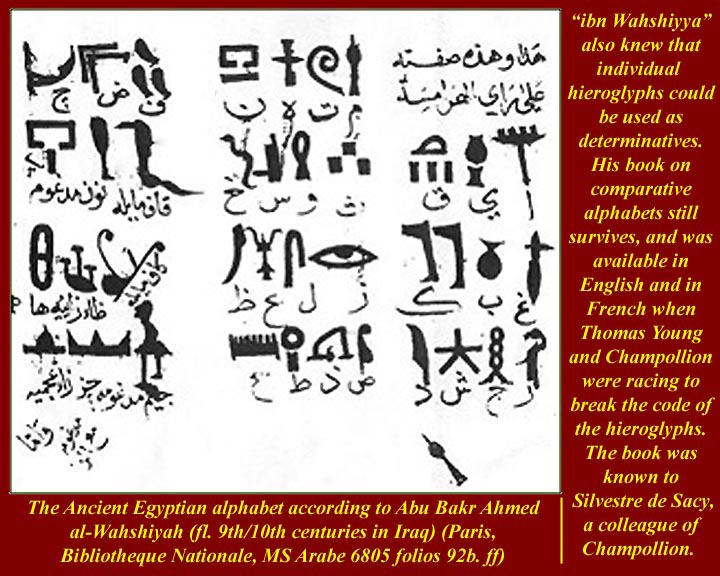
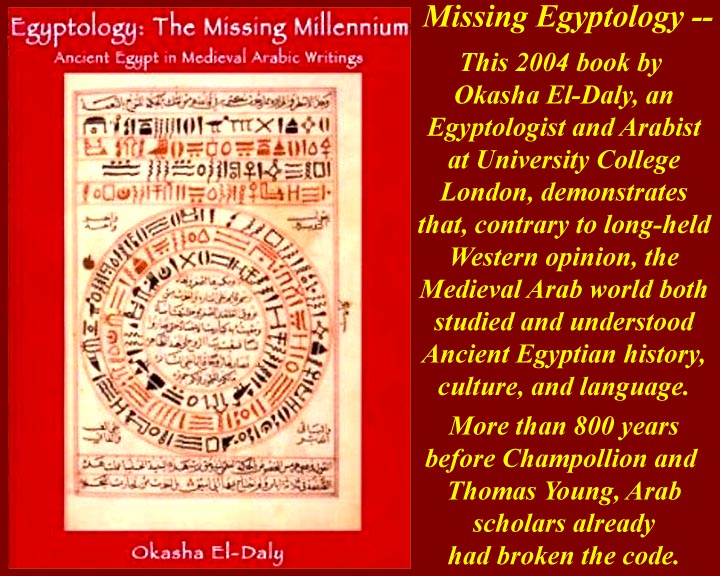
Earlier work by Arabs and by Athanasius Kircher, a German Jesuit who worked in Rome, (http://en.wikipedia.org/wiki/Athanasius_Kircher) had already established the link between Ancient Egyptian and Coptic. One of the Arabs, Ibn Wahshiyyah (http://en.wikipedia.org/wiki/Ibn_Wahshiyya), had deciphered the hieroglyph alphabet more than 800 years before Champollion.
Ibn Wahshiyya was one of the first historians to be able to at least partly decipher what was written in the ancient Egyptian hieroglyphs, by relating them to the contemporary Coptic language used by Coptic priests in his time. An Arabic manuscript of Ibn Wahshiyya's book Kitab Shawq al-Mustaham, a work that discusses a number of ancient alphabets, in which he deciphered a number of Egyptian hieroglyphs, was later read by Athanasius Kircher in the 17th century, and then translated and published in English by Joseph Hammer in 1806 with the very long title Ancient Alphabets and Hieroglyphic Characters Explained; with an Account of the Egyptian Priests, their Classes, Initiation, and Sacrifices in the Arabic Language by Ahmad Bin Abubekr Bin Wahishih, 16 years before Jean-François Champollion's complete decipherment of Egyptian hieroglyphs. This book was known to Silvestre de Sacy, a colleague/competitor of Jean-François Champollion. Dr Okasha El Daly, at University College London's Institute of Archaeology, claims that some hieroglyphs had been decoded by Ibn Wahshiyya, eight centuries earlier than Champollion deciphered the Rosetta stone.
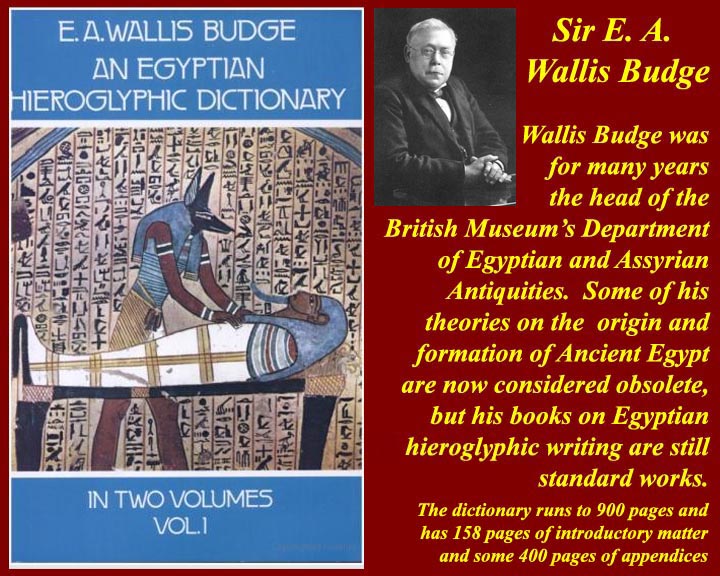
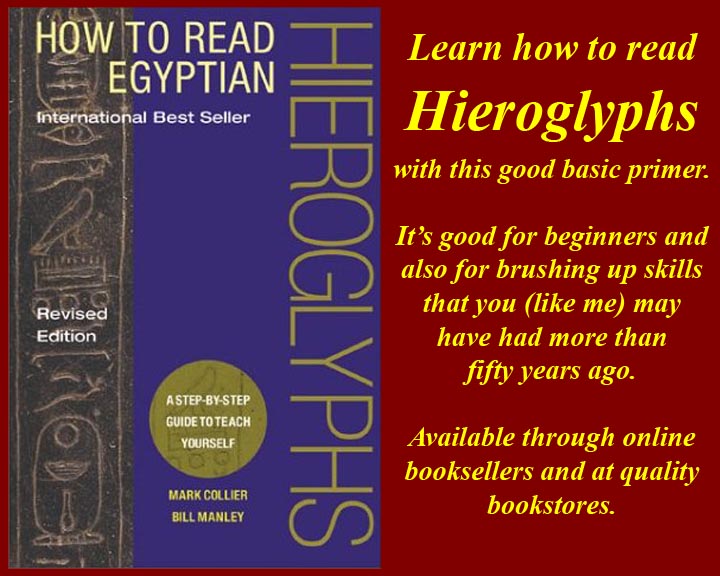
http://www.mmdtkw.org/EGtkw0309WallisBudge.jpg
http://www.mmdtkw.org/EGtkw0309xHieroglyphPrimer.jpg
Wallis Budge (http://en.wikipedia.org/wiki/E._A._Wallis_Budge) began his career at the British Museum in 1883 and stayed until 1924 rising to the top job in his department, the Keeper of Egyptian and Assyrian Antiquities, in 1894. Except among Egyptologists, he is most remembered today for his work in classifying and teaching hieroglyphic writing.
Have you forgotten how to read hieroglyphs? Revive your past skills with How to Read Egyptian.
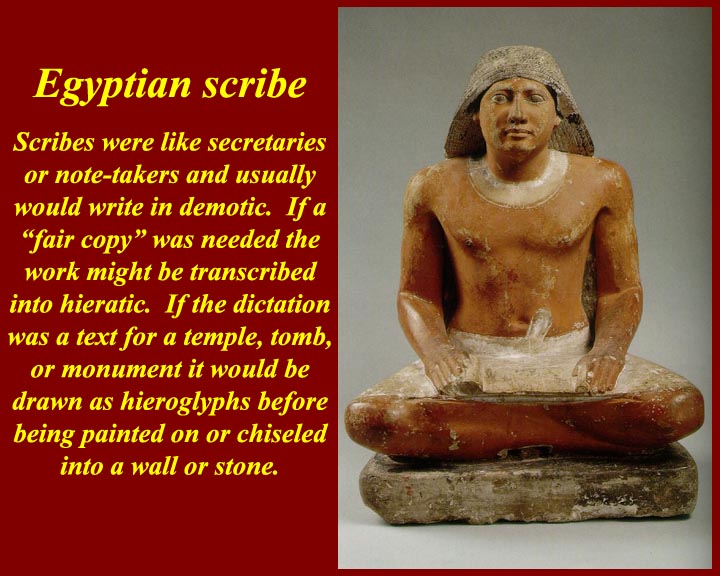
http://www.mmdtkw.org/EGtkw0310Scribe.jpg
The most important man in the history of hieroglyphic writing was, of course, the scribe.
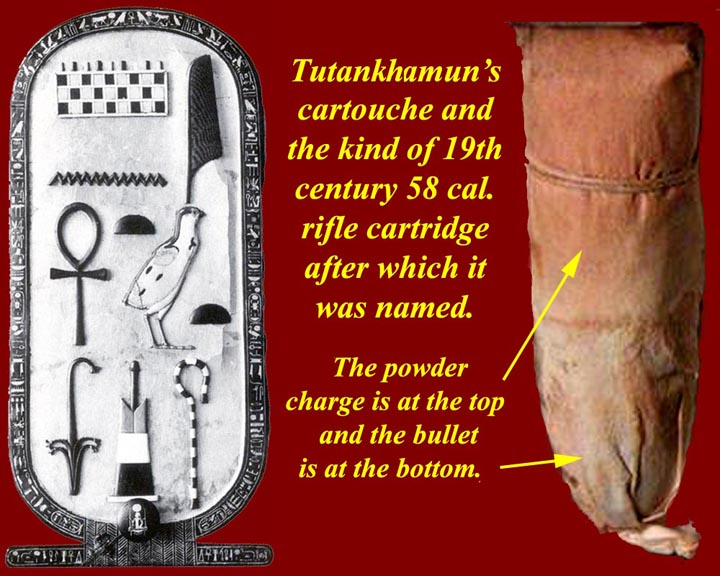
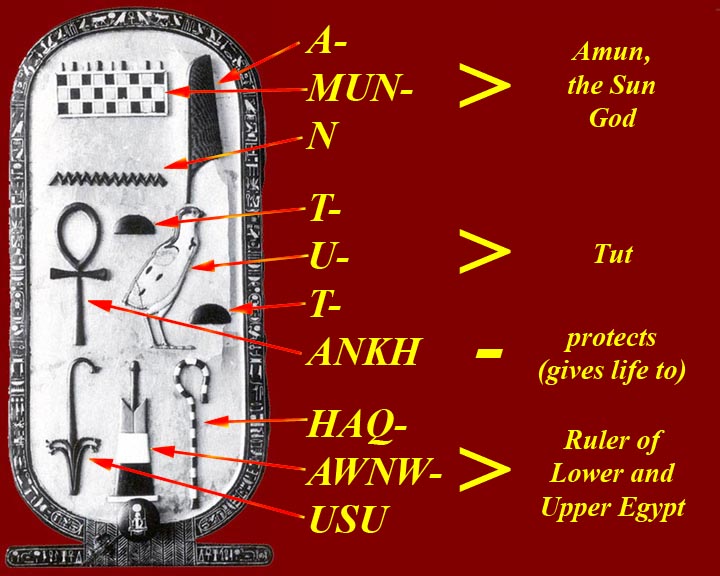
http://www.mmdtkw.org/EGtkw0311TutankamunCartouche.jpg
http://www.mmdtkw.org/EGtkw0311xTutankamunCartouche.jpg
The royal cartouche got its name because members of Napoleon's expeditionary force though it looked like their paper-wrapped cartridge -- cartouche in French (meaning "paper-wrapped thingy").
By the way, the name in this cartouche, which we usually render as "Tut-ankh-amun", is actually written "A-MUN-N / T-U-T-ANKH / HAQ-AWNW-USU". That translates out to "Tut, protected by or endowed with life by (ankh) Amun, Ruler (haq) of Heliopolis (awnw) (representing Lower Egypt) and of Upper Egypt (usu)". The "HAQ-AWNW-USU" part, which is an honorific title that often appears in cartouches, is usually just translated as "Ruler of Lower and Upper Egypt". The name Tutankhamun is a modernism.
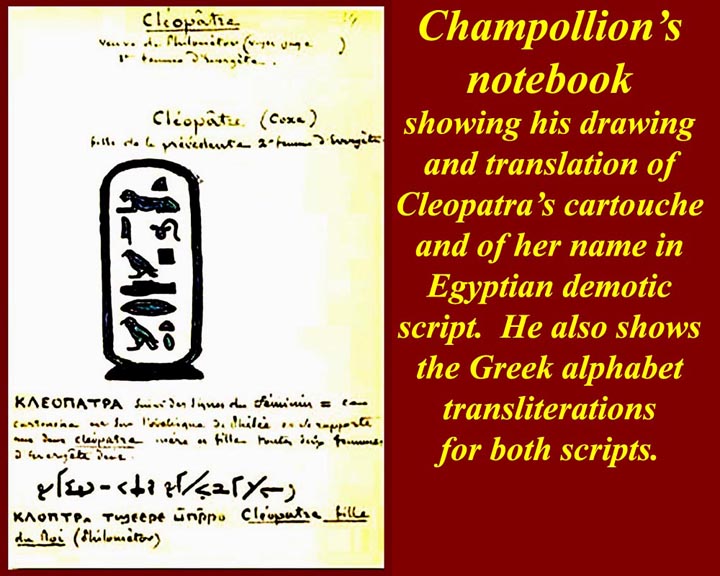
http://www.mmdtkw.org/EGtkw0312ChampollionsNotes.jpg
Champollion wasn't the first to guess that a cartouche would contain a royal name, but he was the first (Westerner) to figure out that the hieroglyphs inside the cartouche represented sounds (phonemes) and then to connect the phonemes into names that were known from other languages. This page from his notebooks shows his translation of the name of Cleopatra. He realized however, that translating Greek names wasn't the same as translating Egyptian words.
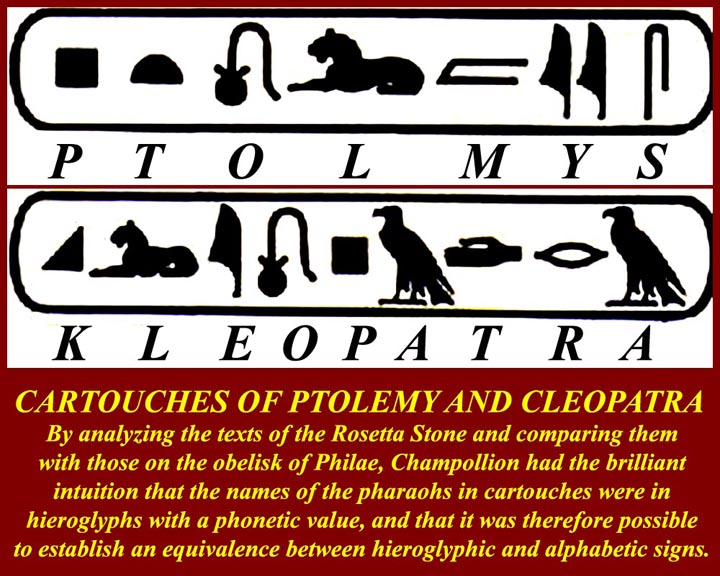
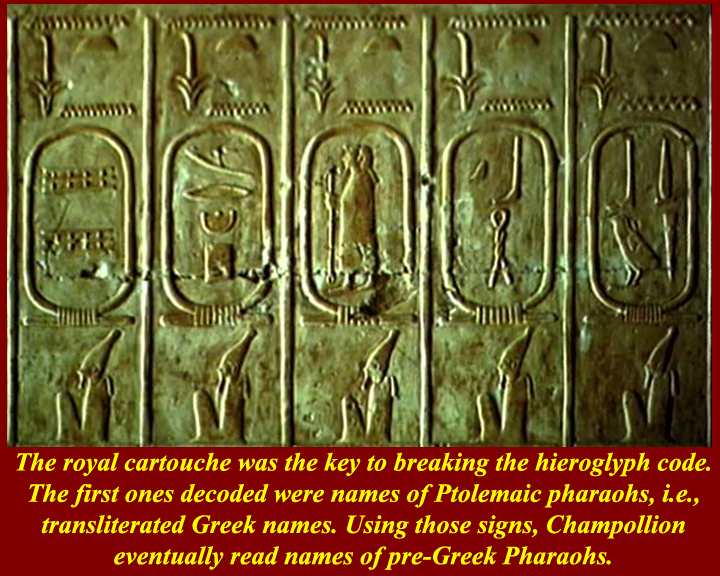
http://www.mmdtkw.org/EGtkw0313PtolCleoCartouches.jpg
http://www.mmdtkw.org/EGtkw0315CartoucheTheKey.jpg
The first cartouche that was translated was that of Ptolemy (Ptolomeos), the issuer of the Rosetta Stone. Champollion later transposed the last symbol (= s) into the name of Ramesses.
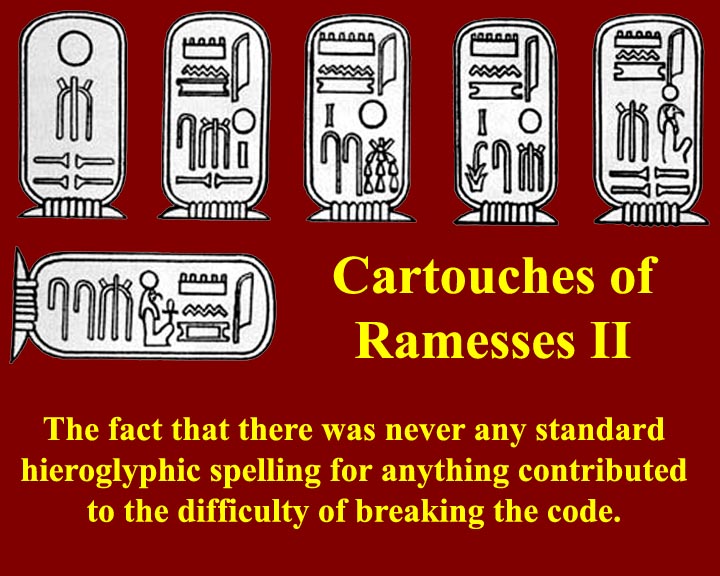
http://www.mmdtkw.org/EGtkw0314aRamessesIICartouche.jpg
One of the details that confused potential translators was that there was no set way to spell anything in ancient Egyptian: it was all based on sound and all sounds were represented by multiple symbols.
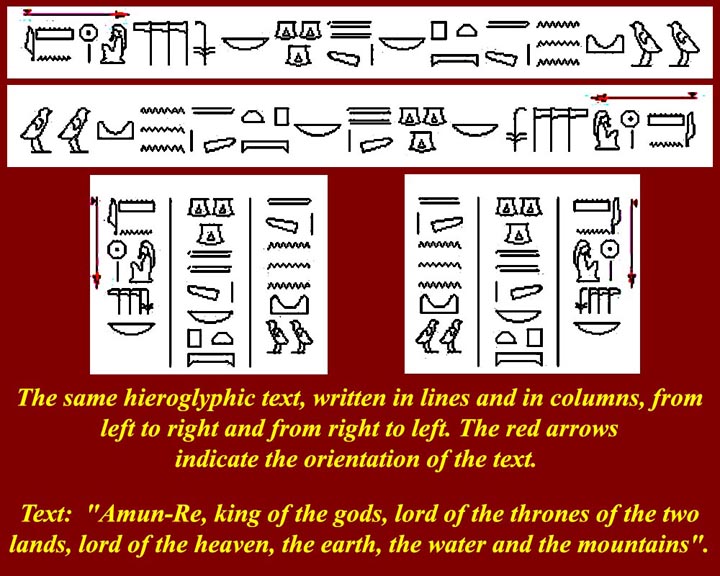
http://www.mmdtkw.org/EGtkw0314bHieroglyphOrientation.jpg
Hieroglyphs could be written in either direction or in columns, and the columns could also be arranged in either direction. There could even be lines within the columns. The trick is to look at the direction that most of the people and animals are facing. Sometimes one or more will be facing the wrong way (they are special cases: departing or going back), but the majority will be looking toward the beginning of the line.
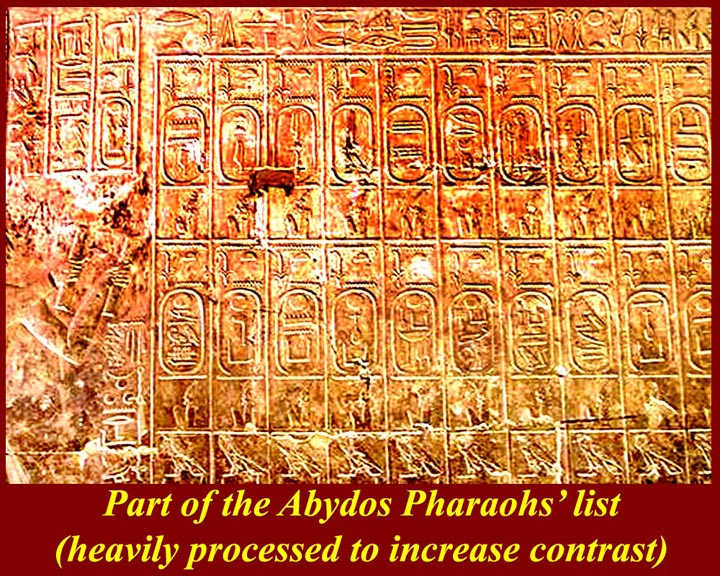
http://www.mmdtkw.org/EGtkw0316aAbydosSetiPharaohs.jpg
Seti's Abydos temple contains one of the most reliable hieroglyphic list of the cartouches of the pharaohs.
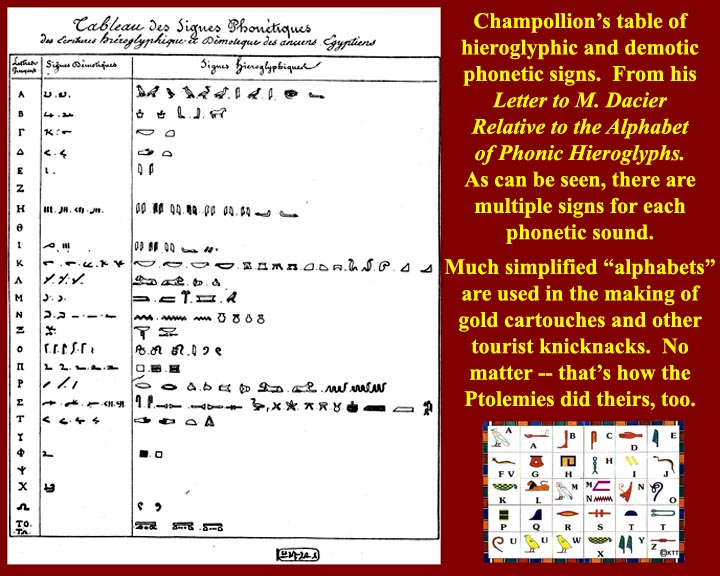
http://www.mmdtkw.org/EGtkw0316bChampollionsPhonics.jpg
Champollion's list of hieroglyphic phonemes.
http://www.mmdtkw.org/EGtkw0317HieroglyphKarnak.JPG
Hieroglyphic symbol cut in stone are a feature of temple walls. These at Karnak are deeply incised. They could also be done in raised relief.
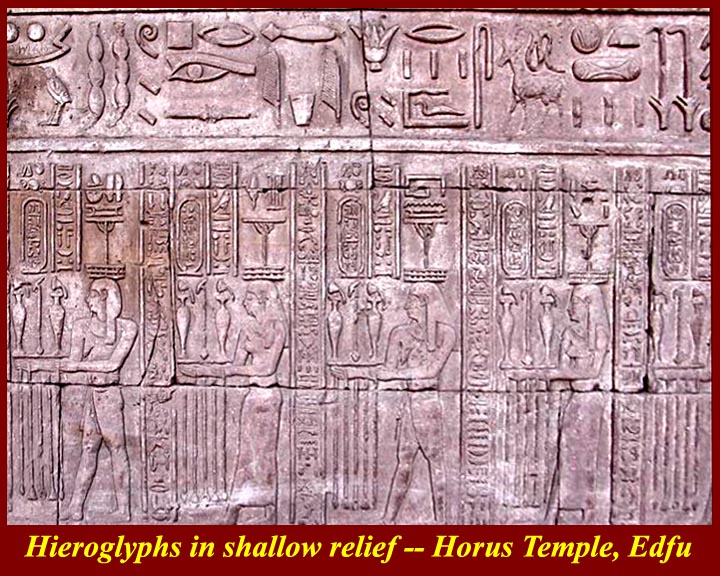
http://www.mmdtkw.org/EGtkw0318EdfuHorusTempleHierogliphsRelief.jpg
Hieroglyphs in shallow relief at the Horus temple in Edfu.
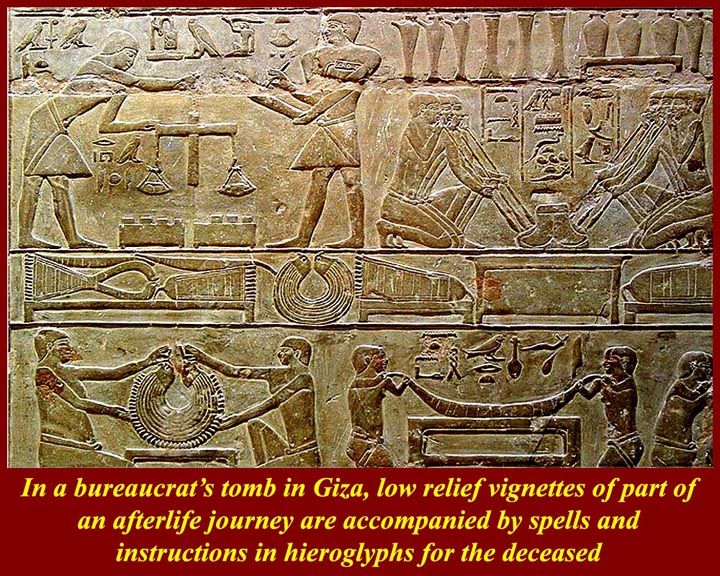
http://www.mmdtkw.org/EGtkw0319HieroglyphicCarving.jpg
Vignettes in a bureaucrat's tomb in Giza of an afterlife journey are accompanied by spell formulas and reminders of how to behave when greeting the gods.
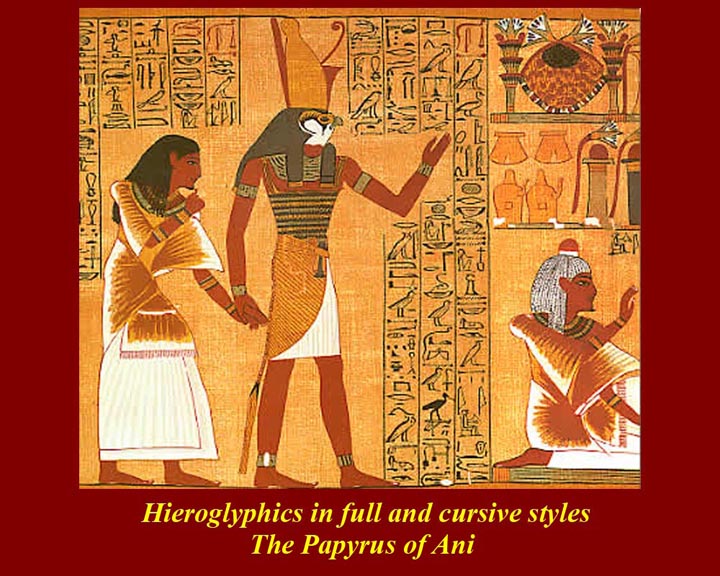
http://www.mmdtkw.org/EGtkw0320HieroglyphicCursiveAni1.jpg
A "cursive" style of scribal hieroglyphs was sometimes used in scroll books.
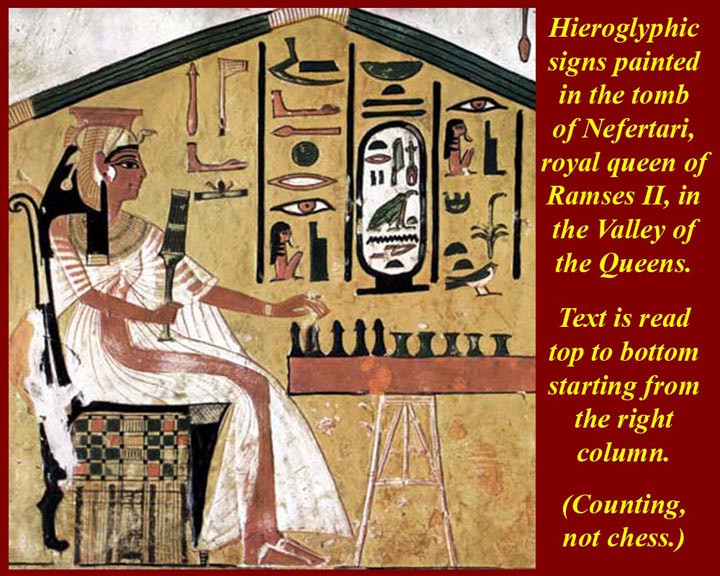
http://www.mmdtkw.org/EGtkw0321HieroglyphicNefertari.jpg
A more detailed style was painted on walls as are these from the tomb of Nefertari, the wife of Ramesses II, in the Valley of the Queens.
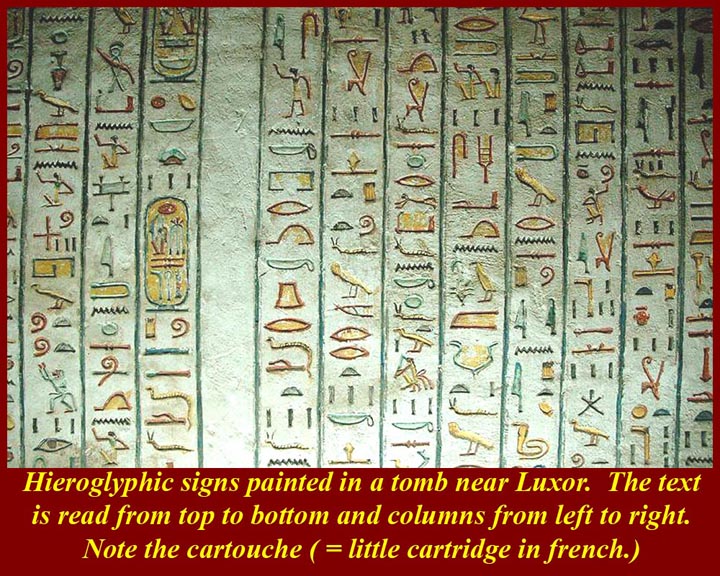
http://www.mmdtkw.org/EGtkw0322HieroglyphicPainting.jpg
An intermediate style from a tomb opposite Luxor. It was all a matter of money -- how much were you able willing to spend on your tomb decoration. Tombs were normally built by their occupants, before their death.
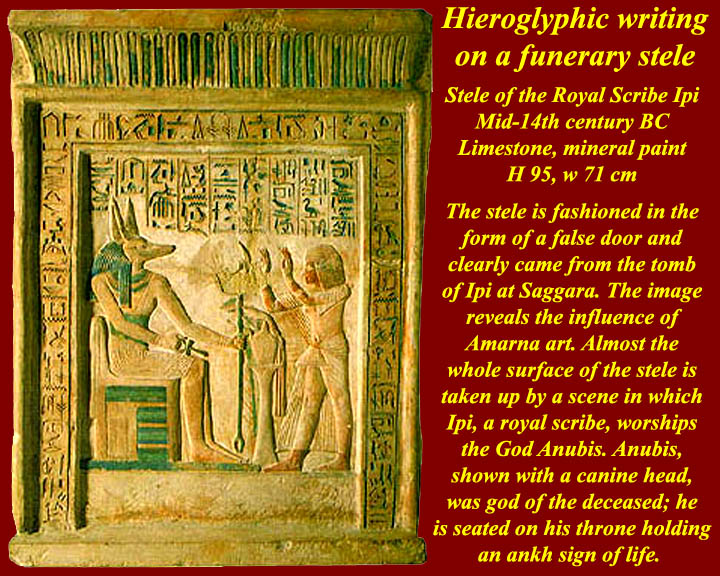
http://www.mmdtkw.org/EGtkw0323HieroglyphicFuneraryStele.jpg
Paint highlighted sculpted hieroglyphs.
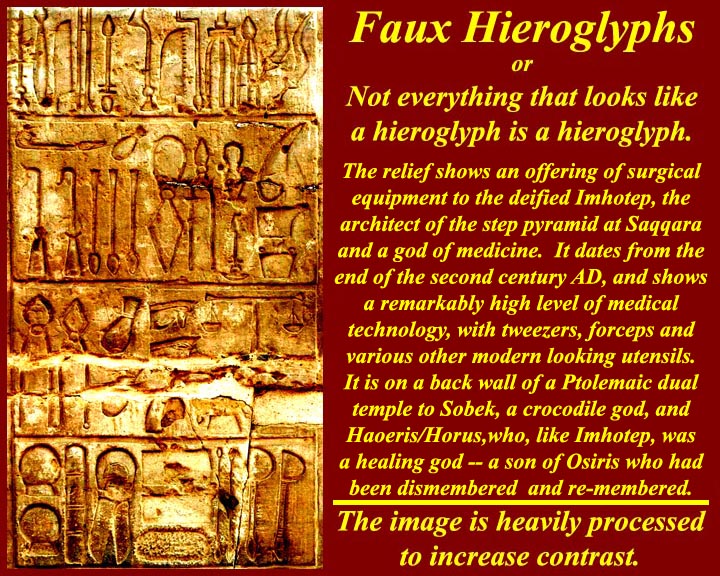
http://www.mmdtkw.org/EGtkw0324KomOmboMedRelief.jpg
Hieroglyphs weren't the only things cut in stone. This relief shows a collection -- almost a catalog -- of medical tools. The relief is thought to be the oldest illustration of such items.
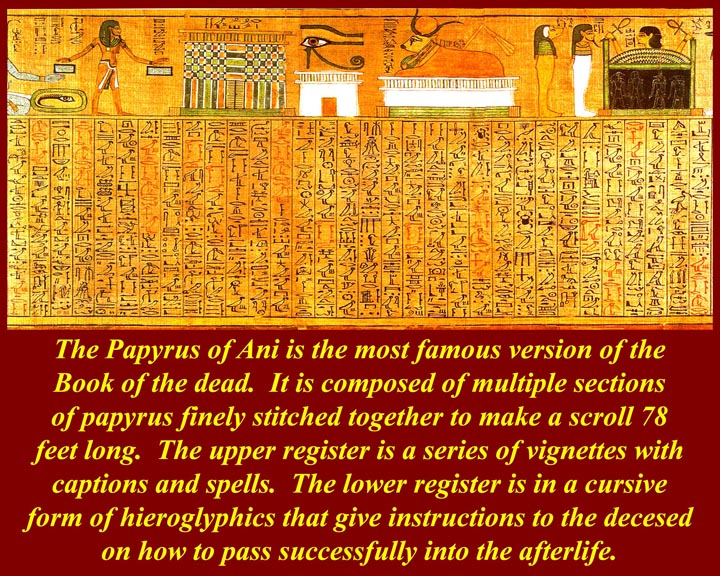
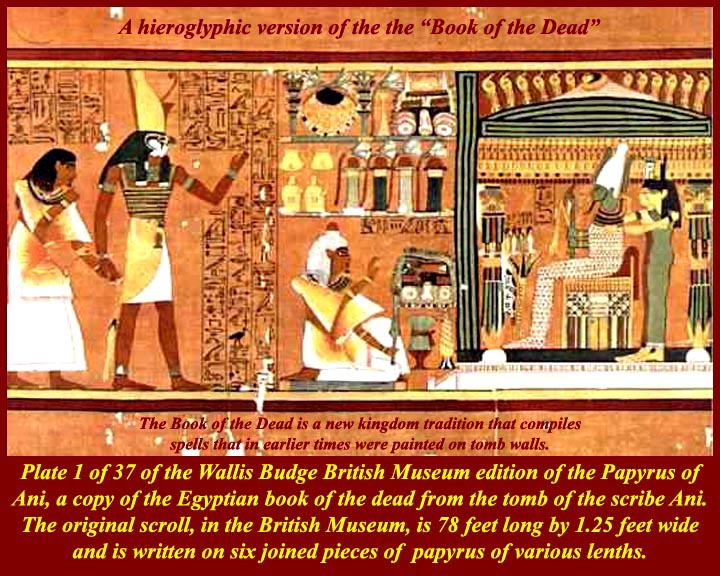
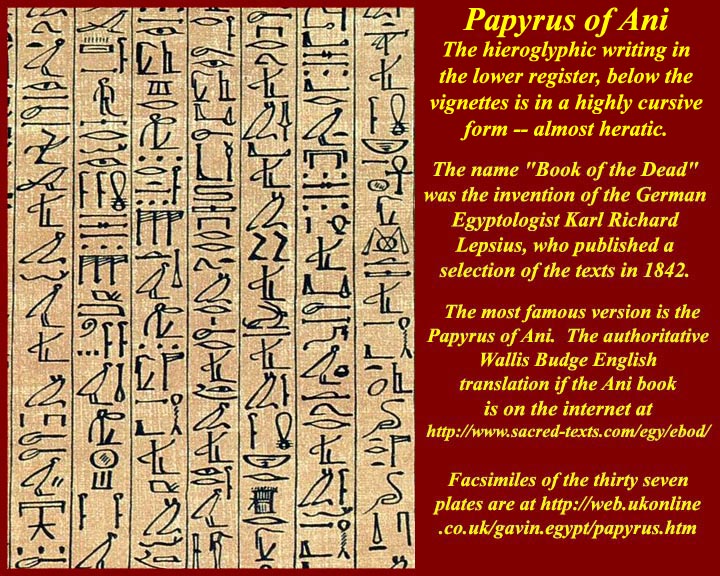
http://www.mmdtkw.org/EGtkw0325aHieroglyphicAniP1.jpg
http://www.mmdtkw.org/EGtkw0325bHieroglyphicAniP1.jpg
http://www.mmdtkw.org/EGtkw0326Papyrus_Ani_curs_hiero.jpg
By the time of the New Kingdom, spells and images that had previously been painted on the walls of elite tombs were being copied into mass produced scroll sections that would be stitched together and placed into tombs of all classes -- sometimes right in the sarcophagus with the mummy. They varied in quality. In some cases mass produced sections would be integrated with specially produced sections, so, even internally, there could be a good deal of variation in quality. One of the best quality "Books of the Dead" is that of A scribe named Ani, although even this book (scroll) has some lower quality insertions. It is done in several scribal hands and it is clear that some of the vignettes were mass produced: exact vignette copies in the same hands are available. The hieroglyphic writings also were clearly added after the vignette images were drawn: in some places the hieroglyphic material is cramped and compressed to fit and even is written in the margins. The Wallis Budge translation and commentaries on the Book of the Dead and, more specifically, on the Ani Papyrus is on the Internet at http://www.sacred-texts.com/egy/ebod/.
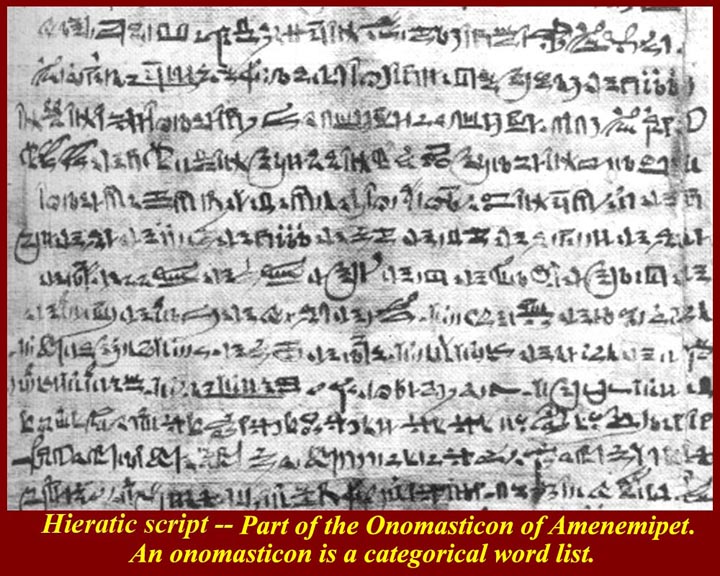
http://www.mmdtkw.org/EGtkw0327HieraticWriting.jpg
An example of hieratic script in the Onomasticon of Amenemepet. The Onomasticon of Amenemipet (also known as the "Onomasticon of Amenemope") is an onomasticon of late New Kingdom date.
The Onomasticon of Amenemipet is the sole onomastic composition that names its compiler and is the onomasticon known from the greatest number of sources, from the Ramesside period through the late Third Intermediate Period. Onomasticon is the Latinized writing of a Greek word (plural: onomastica) used by Egyptologists for ancient Egyptian compositions comprising lists of words by category. These are not dictionaries or explicit encyclopedia, because they do not include explanations for the words. However, the order and selection of words provide an implicit guide to the categories into which the Egyptians divided the world. More information is available on the Internet at http://www.digitalegypt.ucl.ac.uk/literature/onomastica.html and at http://www.archaeowiki.org/Onomasticon_of_Amenemope, which are the sources for the explanation above.
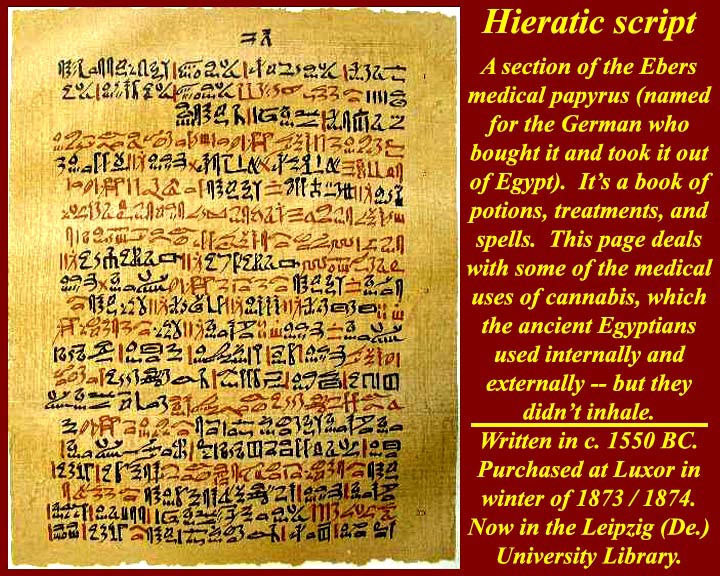
http://www.mmdtkw.org/EGtkw0328EberstHieratic.jpg
Hieratic writing from the Ebers medical papyrus. The Ebers Papyrus (named for its purchaser) is a scroll 20.23 meters in length and contains 108 columns of text. It is dated at the reign of Amenophis I (1536 B.C.). It is among the most important ancient Egyptian medical papyri and is one of two of the oldest preserved medical documents anywhere, the other being the Edwin Smith papyrus (c. 1600 BC). Another important medical papyrus is the Brugsch papyrus (c. 1300 BC). The Ebers papyrus was purchased at Luxor (Thebes) in the winter of 1873–74 by Georg Ebers and is now in the library of the University of Leipzig, Germany. More information on the Papyrus and on Egyptian medical treatments are at http://en.wikipedia.org/wiki/Ebers_papyrus and at http://www.egyptologyonline.com/Medicine.htm.
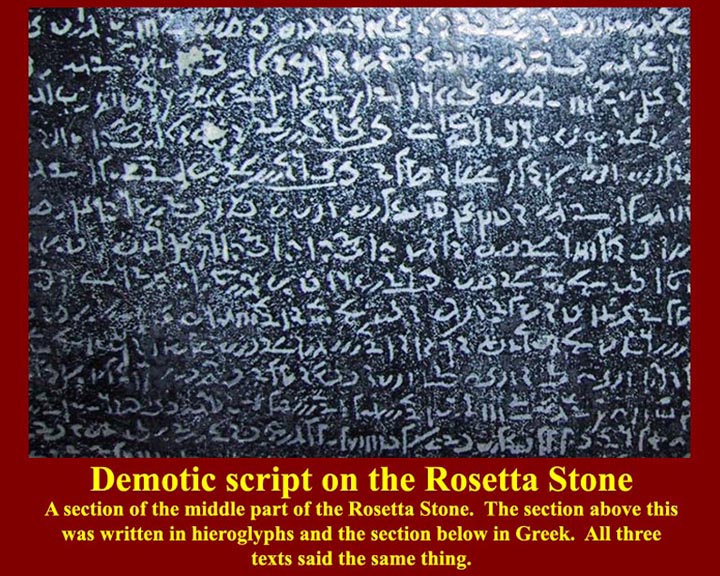
http://www.mmdtkw.org/EGtkw0329DemoticScriptsRosettaStoneReplica.jpg
The best known example of demotic, the third ancient Egyptian script, is the middle section of the Roestta Stone. Champollion first deciphered the demotic text and then moved on to the hieroglyphic text above it.
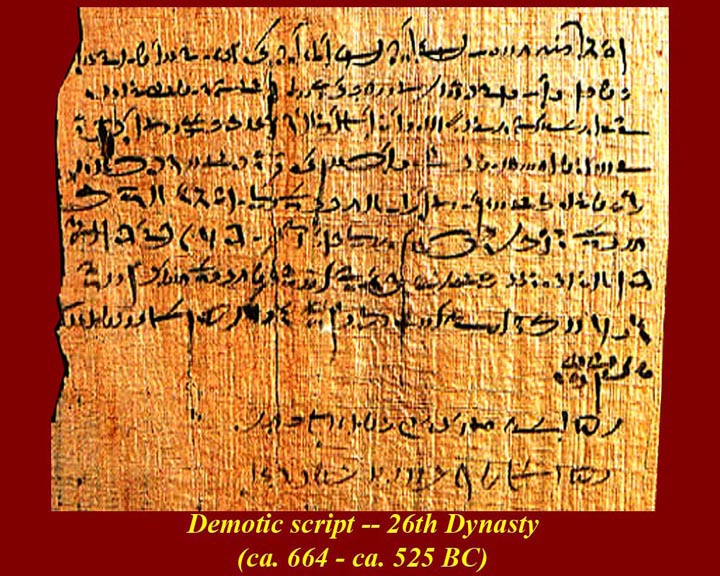
http://www.mmdtkw.org/EGtkw0330Demotic26thDynasty.jpg
26th Dynasty demotic script. Old, Middle, and Late Egyptian were all written using hieroglyphs and hieratic. Demotic was written using a script derived from hieratic; its appearance is vaguely similar to modern Arabic script and is also written from right to left (although the two are not related).
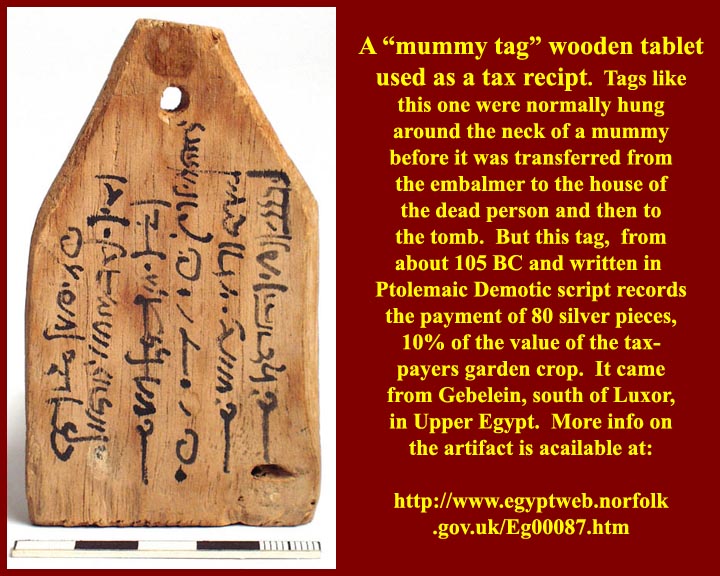
http://www.mmdtkw.org/EGtkw0331MummyTagTaxReceipt.jpg
Mummy tags were hung around the necks of mummies at the embalming shop so that Mrs. Neferjudy wouldn't collect the wrong body. This tag, however, is actually a tax receipt written and signed by the tax collector on whatever came to hand.
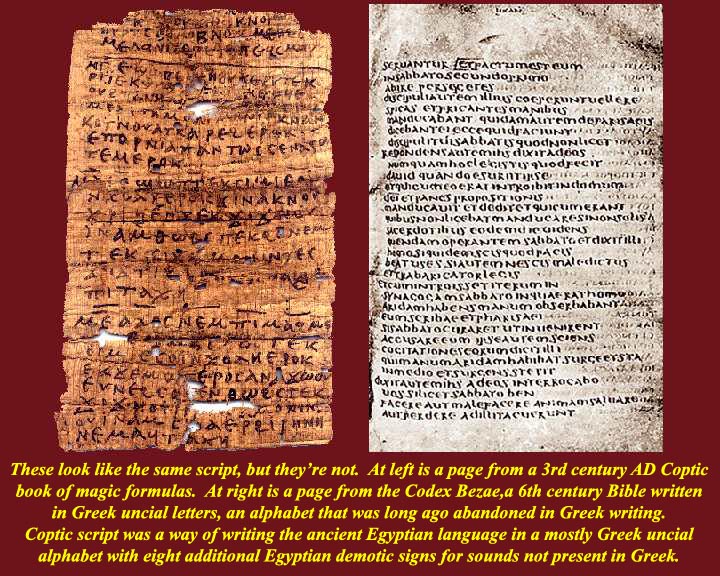
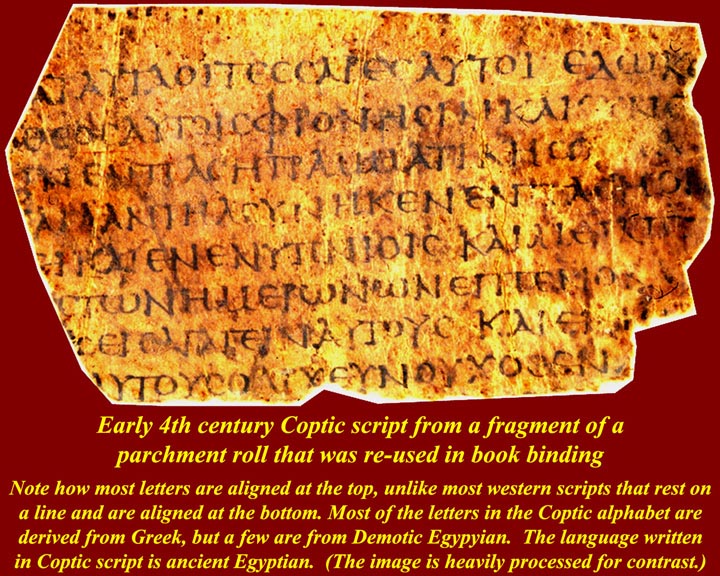
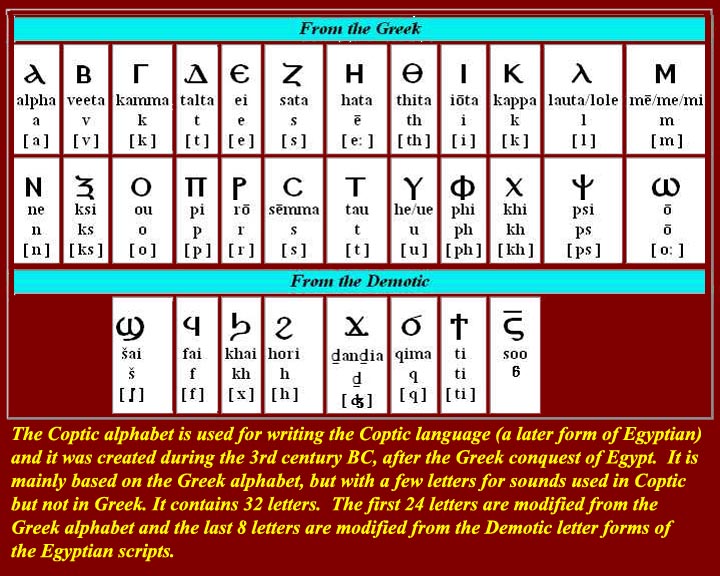
http://www.mmdtkw.org/EGtkw0336CopticGreekUncial.jpg
http://www.mmdtkw.org/EGtkw0332CopticScript.jpg
http://www.mmdtkw.org/EGtkw0333CopticScript.jpg
The last script in which the ancient Egyptian language was written was the Coptic script. In essence, it was ancient Egyptian written in the Greek uncial script (which has long since been abandoned by the Greek language) with six additional letters drawn from demotic script. The whole of the Greek alphabet was adopted, and Greek letters that did not correspond to Egyptian sounds were used as numbers. The final count of letters was 32, and neatly represented the Egyptian language at the beginning of the first millennium AD. The word Copt was originally from the Greek word "aiguptios", meaning 'Egyptian'. It was shortened to "guptios", then transmitted into Arabic as "qopt", and finally back into Egyptian as "coptos". As the name implies, the Coptic script represented the Egyptian language just as Egyptian hieroglyphics had done for 3000 years before. More information on Coptic is on the Internet at http://www.omniglot.com/writing/egyptian_demotic.htm. The most important set of Coptic documents from a modern philologic viewpoint are those found in 1945 at Nag Hammadi in Egypt: for information on them, see http://www.tertullian.org/rpearse/manuscripts/nag_hammadi.htm, and at http://www.touregypt.net/featurestories/naghammadi.htm.
